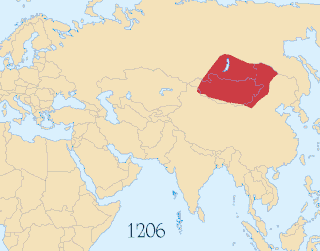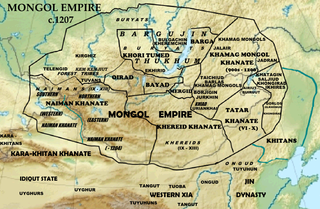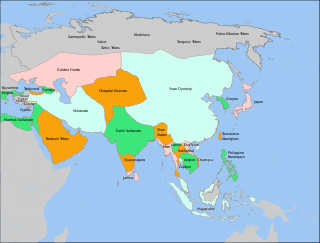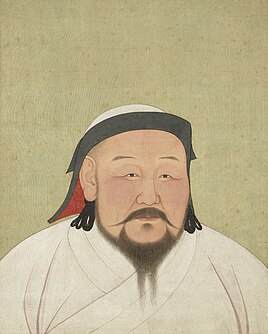
The Society for Creative Anachronism (SCA) is an international living history group with the aim of studying and recreating mainly Medieval European cultures and their histories before the 17th century. A quip often used within the SCA describes it as a group devoted to the Middle Ages "as they ought to have been", choosing to "selectively recreate the culture, choosing elements of the culture that interest and attract us". Founded in 1966, the non-profit educational corporation has over 30,000 paid members as of 2017 with about 60,000 total participants in the society.

The Mongol invasion of Kievan Rus' was part of the Mongol invasion of Europe, in which the Mongol Empire invaded and conquered Kievan Rus' in the 13th century, destroying numerous cities, including Ryazan, Kolomna, Moscow, Vladimir and Kiev, with the only major cities escaping destruction being Novgorod and Pskov.

The Golden Horde, self-designated as Ulug Ulus, lit. 'Great State' in Turkic, was originally a Mongol and later Turkicized khanate established in the 13th century and originating as the northwestern sector of the Mongol Empire. With the fragmentation of the Mongol Empire after 1259 it became a functionally separate khanate. It is also known as the Kipchak Khanate or as the Ulus of Jochi.

Khan is a historic title of Inner Asia used in some medieval Central Asian societies to refer to a ruler or military leader. It first appears among the Rouran and then the Göktürks as a variant of khagan and implied a subordinate ruler. In the Seljuk Empire, it was the highest noble title, ranking above malik (king) and emir (prince). In the Mongol Empire it signified the ruler of a horde (ulus), while the ruler of all the Mongols was the khagan or great khan. The title subsequently declined in importance. In Safavid Persia it was the title of a provincial governor, and in Mughal Empire it was a high noble rank restricted to courtiers. After the downfall of the Mughals it was used promiscuously and became a surname. Khan and its female forms occur in many personal names, generally without any nobiliary of political relevance, although it remains a common part of noble names as well.

Batu Khan, also known as Tsar Batu in Russian historiography, was a Mongol ruler and founder of the Golden Horde, a constituent of the Mongol Empire. Batu was a son of Jochi, thus a grandson of Genghis Khan. His ulus ruled over the Kievan Rus', Volga Bulgaria, Cumania, and the Caucasus for around 250 years.

The Mongol Empire of the 13th and 14th centuries was the largest contiguous land empire in history and the second largest empire by landmass, second only to the British Empire. Originating in Mongolia in East Asia, the Mongol Empire eventually stretched from Eastern Europe and parts of Central Europe to the Sea of Japan, extending northward into parts of the Arctic; eastward and southward into the Indian subcontinent, Mainland Southeast Asia and the Iranian Plateau; and westward as far as the Levant, Carpathian Mountains and to the borders of Northern Europe.
An appanage, or apanage, is the grant of an estate, title, office or other thing of value to a younger child of a sovereign, who would otherwise have no inheritance under the system of primogeniture. It was common in much of Europe.

The Principality or, from 1253, Kingdom of Galicia–Volhynia, also known as the Kingdom of Rus, was a medieval state and vassal of the Golden Horde in the Eastern European regions of Galicia and Volhynia that existed from 1199 to 1349. Its territory was predominantly located in modern-day Ukraine and Belarus. Along with Novgorod and Vladimir-Suzdal, it was one of the three most important powers to emerge from the collapse of Kievan Rus. The main language was Old East Slavic, a predecessor to Ukrainian, Belarusian and Russian, and the official religion was Eastern Orthodoxy.

A Borjigin is a member of the Mongol sub-clan, which started with Bodonchar Munkhag of the Kiyat clan. Yesugei's descendants were thus said to be Kiyat-Borjigin. The senior Borjigids provided ruling princes for Mongolia and Inner Mongolia until the 20th century. The clan formed the ruling class among the Mongols and some other peoples of Central Asia and Eastern Europe. Today, the Borjigid are found in most of Mongolia, Inner Mongolia and Xinjiang, and additionally genetic research has shown that descent from Genghis Khan is common throughout Central Asia and other regions.

The Kingdom of Calontir is one of twenty "kingdoms", or regions, of the Society for Creative Anachronism (SCA), an international organization dedicated to researching and recreating aspects of the European Middle Ages.

The Mongol invasion of Europe in the 13th century occurred from the 1220s into the 1240s. In Eastern Europe, the Mongols conquered Volga Bulgaria, Cumania, Alania, and the Kievan Rus' federation. In Central Europe, the Mongol armies launched a two-pronged invasion of fragmented Poland, culminating in the Battle of Legnica, and the Kingdom of Hungary, culminating in the Battle of Mohi. Invasions also were launched into the Caucasus against the Kingdom of Georgia and the Chechens and Ingush, as well as into the Balkans against Croatia, the Second Bulgarian Empire, and the Latin Empire. The operations were planned by General Subutai (1175–1248) and commanded by Batu Khan and Kadan. Both men were grandsons of Genghis Khan. Their conquests integrated much of Eastern European territory into the empire of the Golden Horde. Warring European princes realized they had to cooperate in the face of a Mongol invasion, so local wars and conflicts were suspended in parts of central Europe, only to be resumed after the Mongols had withdrawn. After the initial invasions, subsequent raids and punitive expeditions continued into the late 13th century.

Turco-Mongol or the Turko-Mongol tradition was an ethnocultural synthesis that arose in Asia during the 14th century, among the ruling elites of the Golden Horde and the Chagatai Khanate.

Kublai, also known as the Emperor Shizu of Yuan, was the fifth khagan-emperor of the Mongol Empire, reigning from 1260 to 1294. He also founded the Yuan dynasty in China as a conquest dynasty in 1271, and ruled as the first Yuan emperor until his death in 1294.

A paiza or paizi or gerege was a tablet carried by Mongol officials and envoys to signify certain privileges and authority. They enabled Mongol nobles and officials to demand goods and services from civilian populations.
According to Rashid-al-Din Hamadani (1247–1318), Genghis Khan's eldest son, Jochi, had nearly 40 sons, of whom he named 14. When he died, they inherited their father's dominions as fiefs under the rule of their brothers, Batu Khan, as supreme khan and Orda Khan, who, although the elder of the two, agreed that Batu enjoyed primacy as the Khan of the Golden Horde.
During the 13th and 14th centuries, the Mongols launched two long, massive invasions of the territory of modern Chechnya and Ingushetia, which included the lands of Alania in the West, Simsir in the Northeast, and the Georgian-allied polity of Durdzuketia in the South. They caused massive destruction and human death for the Durdzuks, but also greatly shaped the people they became afterward. The ancestors of the Chechens and Ingush bear the distinction of being one of the few peoples who have managed to fight the Mongols and win, not once, but twice. However, this came at great cost to them, and the states they had set up were utterly destroyed as was their previous organized systems. These invasions are among the most significant occurrences in Chechen and Ingush history, and have had long-ranging effects on Chechnya, Ingushetia and their peoples.

The Mongols were highly tolerant of most religions during the early Mongol Empire, and typically sponsored several at the same time. At the time of Genghis Khan in the 13th century, virtually every religion had found converts, from Buddhism to Eastern Christianity and Manichaeanism to Islam. To avoid strife, Genghis Khan set up an institution that ensured complete religious freedom, though he himself was a Shamanist. Under his administration, all religious leaders were exempt from taxation, and from public service. Mongol emperors were known for organizing competitions of religious debates among clerics, and these would draw large audiences.
The Vagindra script is an alphabetic script for the Buryat language developed by Agvan Dorzhiev in the first decade of the 20th century. It was used only briefly.
The division of the Mongol Empire began when Möngke Khan died in 1259 in the siege of Diaoyu Castle with no declared successor, precipitating infighting between members of the Tolui family line for the title of khagan that escalated into the Toluid Civil War. This civil war, along with the Berke–Hulagu war and the subsequent Kaidu–Kublai war, greatly weakened the authority of the great khan over the entirety of the Mongol Empire, and the empire fractured into autonomous khanates: the Golden Horde in Eastern Europe, the Chagatai Khanate in Central Asia, the Ilkhanate in Southwest Asia, and the Yuan dynasty in East Asia based in modern-day Beijing – although the Yuan emperors held the nominal title of khagan of the empire. The four divisions each pursued their own interests and objectives and fell at different times.













